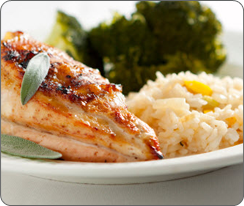What is an Elimination Diet?
If you’ve ever had a suspected food allergy or food intolerance, your physician, allergist or dietitian may suggest trying an elimination diet and subsequent food challenge test.
Elimination diets involve removing specific foods or ingredients from the diet for a specified period of time, typically a minimum of several weeks, and then reintroducing each food or ingredient one at a time, while carefully paying attention to any symptoms that arise after reintroducing the food.
Anyone who is on an elimination diet must pay acute attention to foods, beverages, ingredients and food preparation methods. Though taking out some foods may be obvious, corn chips if you are allergic to corn for instance, other sources of the food or ingredient may not be so obvious (Did you know some companies dust their bread with corn meal?).

Elimination diets are typically “prescribed” by a physician. While on an elimination diet, it is helpful to keep a food diary that includes a detailed record of the foods you eat, how your food is prepared, as well as the time of each meal or snack.
Record Symptoms
In addition, include any symptoms you are having and the time of day they occurred. If your symptoms go away while on the elimination diet and then return after the re-introduction of a specific food or ingredient, this food or ingredient is one that you are likely allergic to. Eliminate that food or ingredient and see if the symptoms go away. Once a food allergy has been established, the only proven therapy is strict avoidance of the food.
Though elimination diets may help, sometimes identifying a food allergy or intolerance isn’t that easy. In the case of a suspected food allergy, allergy testing can be helpful. And, because detecting a food intolerance or other adverse reaction to a food can be difficult, enlisting the help of a trained healthcare practitioner (and testing in the case of food intolerances) can be very helpful.
Sample Meals in an Elimination Diet
If you want to try an elimination diet, you may be wondering how to start. And there are two main methods people use:

The first involves a very restrictive diet that includes just a few non-allergenic foods (foods that are very unlikely to cause a reaction) such as rice, quinoa, poultry and most vegetables.
The second, more commonly recommended method is to take out all foods or ingredients you suspect are causing an issue. Pay careful attention to mixed dishes, dressings and sauces – leave most of these out of your diet, if possible. Stay off these foods for a specified period of time, as recommended by your physician, and then reintroduce them one by one noting any adverse reactions.
So, let’s say you suspect a wheat allergy, here is a sample one-day elimination diet meal plan (many sauces such as soy sauce are made with wheat):
Snack: a piece of fruit
Lunch: homemade turkey chili and a glass of milk
Snack: string cheese and a piece of fruit
Dinner: grilled chicken, rice and steamed vegetables, glass of milk
Though an elimination diet takes careful planning and a little detective work, it can be a helpful tool for those suffering from food allergies, adverse reactions to food or specific ingredients.
1 Allergy Testing. Medline Plus, NIH. Website: http://m.medlineplus.gov/ency/article/003519.htm
2 American College of Allergy, Asthma, & Immunology. Food allergy: a practice parameter. Ann Allergy Asthma Immunol 2006 Mar;96 (3 Suppl 2):S1-68. http://www.guideline.gov/content.aspx?id=9218
3 Food Allergy, an Overview. National Institute of Allergy and Infectious Diseases, NIH. http://www.niaid.nih.gov/topics/foodallergy/understanding/pages/diagnosis.aspx
4 Pelsser LM, Frankena K, Toorman J, Savelkoul HF, Dubois AE, Pereira R, Haagen TA, Rommese NN, Buitelaar JK. Effects of a restricted elimination diet on the behaviour of children with attention-deficit hyperactivity disorder (INCA study): a randomized controlled trial. Lancet 2011;377: 494-503.
5 Guidelines for the Diagnosis and Management of Food Allergy in the United States. Summary of the NIAID-Sponsored Expert Panel Report. National Institute of Allergy and Infectious Diseases, NIH, HHS. NIH Publication No. 11-7700. December 2010. http://www.niaid.nih.gov/topics/foodallergy/clinical/documents/faguidelinesexecsummary.pdf

